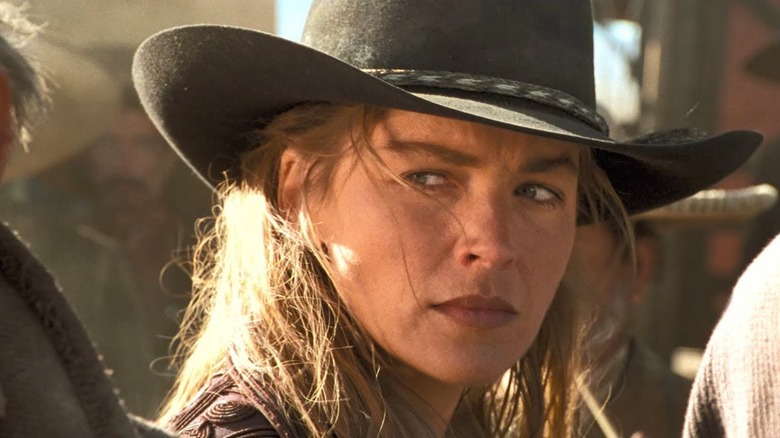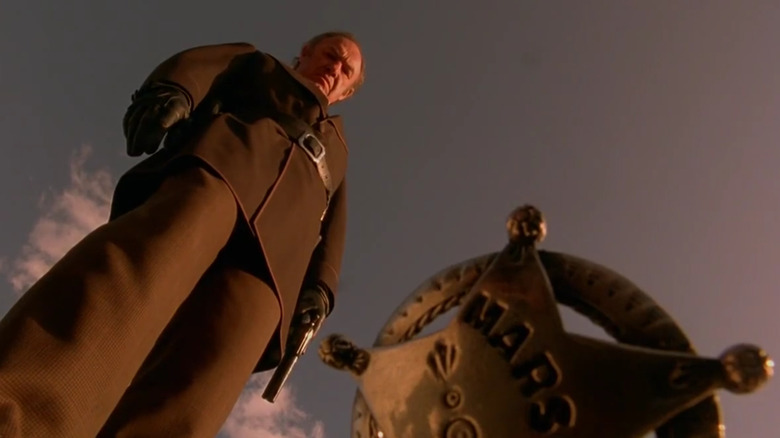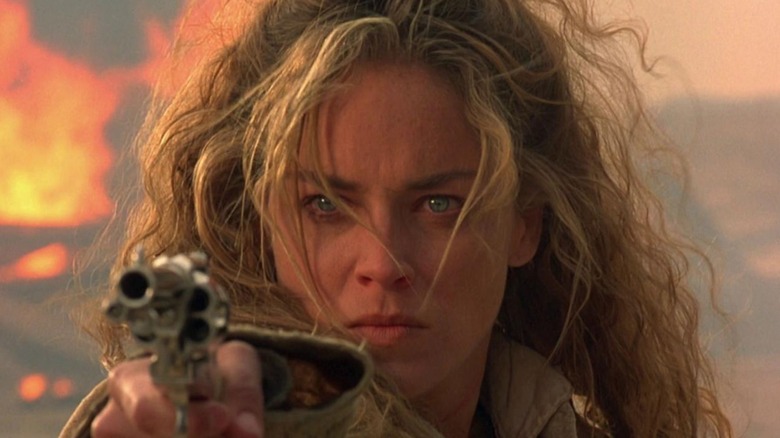The Final Shootout In Sam Raimi's The Quick And The Dead Is The Best Action Scene Ever
(Welcome to Best Action Scene Ever, a column dedicated to breaking down the best, most effective action sequences throughout the genre. In this edition, we dive into the final duel in Sam Raimi's blistering, stylistic, and woefully underrated Western "The Quick and the Dead.")
Who expected Sam Raimi's first appearance in this new weekly column to spotlight one of the many brilliant set pieces in either "Spider-Man" or "Spider-Man 2"? While that would've seemed like the safest bet to make, I couldn't help but find myself drawn to a very different (but no less worthy) entry hidden in the acclaimed filmmaker's holster. 1995's "The Quick and the Dead" feels like one of those quintessential underseen gems that younger viewers were more likely to discover only after Raimi returned to the headlines upon helming "Doctor Strange in the Multiverse of Madness" (in fact, I wrote all about it here), but longtime fans have been singing the film's praises since well before it was trendy to do so.
The distinctive appeal of "The Quick and the Dead" is apparent for anyone to see. With Sharon Stone leading a delightfully throwback Western while the much more obvious cowboy-type Russell Crowe is relegated to second billing, stylistic flourishes like split diopters shots and Dutch angles that only ever add to the story rather than distracting from it, and a series of old-fashioned shootouts designed to evoke larger-than-life emotions, the maximalist thrills of the genre picture all but speak for themselves. But nowhere does the film swing bigger or more earnestly than in the final action sequence, a thoroughly satisfying and go-for-broke conclusion that delivers the best that Raimi has to offer.
So strap on your spurs and 10-gallon hat as we dive into the nitty-gritty of "The Quick and the Dead."
The scene
For as much as "The Quick and the Dead" earns its "revisionist" label, the set-up is as traditional as it gets. A mysterious woman on horseback strolls into the small town Redemption, a silent observer to the histrionics of the much flashier and archetypical characters around her. There's the young and impossibly talented hothead known as "Kid" (Leonardo DiCaprio), a glowering mercenary by the name of Cantrell (Keith David), a former outlaw named Cort who's turned to preaching to redeem his many sins (Russell Crowe), and the big bad of them all — Gene Hackman's Herod, the ferocious gangster currently in command and ruling Redemption. Once identities are revealed and motivations are steadily uncovered (through flowery monologues and evocative flashbacks alike), it's clear that Sam Raimi and writer Simon Moore are working with a powder keg of storytelling that's just waiting to combust.
And combust it does ... at least once the Lady enters herself into the shooting tournament that Herod has set up for sport. As we learn, there are several competing interests among the main players. The Kid simply wants to impress his deadbeat dad, who happens to be Herod (although, beyond their shared expertise with a pistol, the disgruntled villain has no way of proving that). The townspeople have thrown their lot in with chosen champion Cantrell, hoping that he'll prevail over Herod within the confines of the game and free them from his tyranny. Cort is thrust into the proceedings entirely against his will, forced into the violent lifestyle he thought he left behind as punishment for turning his back on old partner Herod.
And the Lady? Hers is the most personal of them all, having been forced as a child to participate in Herod's murder of her father, Redemption's old marshal.
Why it works
By the time the third act rolls around, everything has been primed and ready for the final confrontation. Herod, as if eager to prove his villainy, mortally wounds the Kid in single combat and sends him off to his death without even acknowledging him as his son. With both the Lady (who's real name is Ellen) and Cort among the only survivors left, Herod forces the two unwilling fighters to challenge one another in a shootout — which appears to end with the death of our main hero and an angry Cort vengefully challenging Herod to a duel to the death the next day to end it, once and for all. As the whole town watches as the combatants take their spots and the old clocktower ticks closer to the appointed time, the stakes couldn't possibly be higher for the fate of the innocent townspeople who have no choice but to watch.
And then everything finally explodes.
Raimi stages a spectacular display of earnest and un-self-conscious filmmaking that feels completely alien (but oh so refreshing) from a modern perspective. Quick zoom-ins on the faces of Cort and Herod in the moments before drawing their weapons heighten the tension, Alan Silvestri's orchestral score wears its heart on its sleeve and makes no secret of the emotions it wishes to evoke from audiences, and Pietro Scalia's editing weaves it all together to keep the geography of the setting and the emotions of the characters — no less than three attempts by Herod to shoot Cort dead are interrupted by exploding buildings — at the forefront of the action.
When the debris settles, we get to the real heart of the scene as the presumed-dead Ellen emerges from the smoke and challenges her nemesis in the film's true climactic moment.
The key moment
In just a few minutes, we experience a roller coast of emotions that Raimi and his creative team takes full advantage of. This ranges from the catharsis of seeing Herod's devilishly-contrived shootout with Cort fall to pieces (literally) as Redemption explodes around him, the triumph of the fake-out death reveal as the Lady receives her big hero moment and confronts her tormenter with her knowledge of their shared past, the stomach-churning lows when a young Herod forces the adolescent Ellen to shoot the rope hanging her father in an attempt to free him (the unsteady shooter accidentally kills her father instead, naturally), and the violent emotions finally bubbling to the surface as all pretenses are stripped away for the first and final time.
The key to this sequence, as it turns out, comes from the littlest details. We register the tension-ridden zoom-outs from Stone and Hackman's faces as they prepare to fire, the insert shots of the onlooking townspeople, the visuals of the smoke and flames engulfing the gunslingers, and a shadowy silhouette of a bullet hole as the shots ring out and Herod looks down in confusion. Here, Raimi expertly wields his stylistic choices — both subtle and otherwise — to maximum effect. By the time Ellen delivers the final kill shot and Herod keels over in extremely over-the-top fashion, Raimi needs little more than a minute of screen time to wrap up the main story and send the Lady off into the sunset with a satisfying ending.
It's rare for a movie to saves all its bullets (pun most definitely intended) until the final scene, but "The Quick and the Dead" isn't interested in conforming to expectations or toning itself down. Instead, it provides one of the most visceral action scenes of Raimi's entire filmography.


